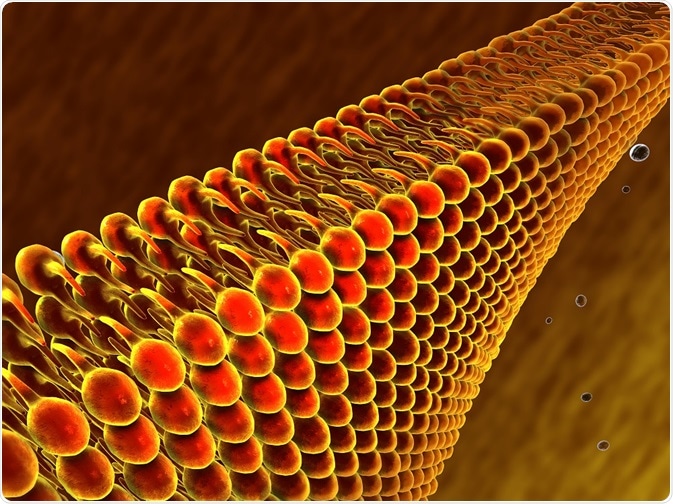Lipidomics refers to the study of cellular lipidomes, meaning the network of lipid constituents that maintain cellular and bodily health. Shotgun lipidomics follows these networks of lipids within biological systems on a larger scale, allowing identification, quantification, and interaction of lipids to be studied.

Image Credit: Naeblys/Shutterstock.com
Lipidomics
The lipidome covers all chemically different lipid entities within a cell. This covers the major groups of lipids in the cell: those forming the membrane bilayer, those responsible for healthy hydrophobic environments crucial for protein function and interaction in the membrane, those used as energy storage reservoirs, and those used as secondary messengers during enzyme activity.
Lipidomics research focuses on changes in lipid interactions. This covers a lot of information, such as the quantities of lipidome constituents, their organization, and understanding their movement in and out of cellular compartments. While the origins of lipidomics date back to the 80s, it expanded rapidly in the 2000s and is still being developed.
Shotgun lipidomics can provide information on more than 20 lipid classes, several hundred molecular species, and can cover over 95% of the cellular lipidome’s mass content. While coverage is high, there are many lipid molecular species present in low abundance that are not well targeted by current shotgun lipidomics techniques.
Methods of Shotgun Lipidomics
Mass spectrometry approaches are used to obtain shotgun lipidomics data. One powerful mass spectrometry method is multi-dimensional mass spectrometry-based shotgun lipidomics (MDMS-SL), which offers high accuracy, efficiency, sensitivity, and reproducibility. MDMS-SL approaches can be targeted or non-targeted, depending on whether specific pathways are under investigation.
Other mass spectrometry techniques associated with shotgun lipidomics are electrospray ionization mass spectrometry (ESI/MS) and tandem mass spectrometry (MS/MS).
Tandem mass spectrometry has been successfully used to characterize several lipid classes, including complex lipids such as phospholipids. Electrospray ionization mass spectrometry classifies lipids on the basis of electrical propensities and can be combined with tandem mass spectrometry for finer analysis.
Mass spectrometry is coupled with intrasource separation and array analysis. Separation occurs based on biophysical properties, such as electrical propensities, and separates specific lipid classes from each other. The array analysis occurs computationally and allows for the identification and quantification of lipid species.
Recent advances have also made it possible to understand the molecular structure of lipids. This is possible because most lipids are combinations of the same building blocks, namely aliphatic chains, backbones, and head groups. Lipid building blocks can be seen in experimental data and be computer reconstructed with regards to their ions to determine the structure. This can allow for further identification of isobaric molecular species.
Applications of Shotgun Lipidomics
The lipidomics of many diseases is of interest to understand how they work and find potential therapeutic targets. Two important examples of diseases where lipid homeostasis is disturbed may be diabetes and obesity, both of which are important health afflictions in many countries. Shotgun lipidomics studies on diabetes have shown that myocardial plasmenylethanolamine species were elevated by 44% in rats with diabetes compared to healthy controls.
Shotgun lipidomics has been applied to study the plasma in patients afflicted with Alzheimer’s disease, in hopes of finding plasma biomarkers. Shotgun lipidomics allowed 800 molecular lipid species to be studied and found several lipids that were altered in Alzheimer’s disease. Eight sphingomyelin species were lower in Alzheimer’s disease plasma, whereas two ceramide species were present in higher quantities. The sphingomyelin species, in particular, were of interest due to their role in neuronal function.
Shotgun lipidomics is of interest to agricultural applications, as well as medical. The method has been applied to plants undergoing cold stress and found significant changes in lipid levels. Lipids such as choline glycerophospholipid, ethanolamine glycerophospholipid, and phosphatidylglycerol were decreased in number, whereas phosphatidic acids, lysophosphatidylcholine, and lysoethanolamine glycerophospholipid levels were increased.
Sources
- Han X., et al. (2011). Metabolomics in early Alzheimer’s disease: identification of altered plasma sphingolipidome using shotgun lipidomics. PLoS ONE. https://doi.org/10.1371/journal.pone.0021643
- Han X. and Gross R.W. (2014). Shotgun lipidomics: multidimensional MS analysis of cellular lipidomes. Expert Review of Proteomics. https://doi.org/10.1586/14789450.2.2.253
- Han X. and Gross R.W. (2004). Shotgun lipidomics: electrospray ionization mass spectrometric analysis and quantitation of cellular lipidomes directly from crude extracts of biological samples. Mass Spectrometry Reviews. https://doi.org/10.1002/mas.20023
Further Reading